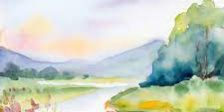When I first started experimenting with watercolor, I thought it would be easy.
I believed that if I painted carefully enough, I could force the water to obey my ideas.
I was wrong.
Watercolor lives its own life on the page. It seeps, blends, and surprises you.
At first, that terrified me. I wanted clean, sharp edges; instead, I got blooms, unexpected puddles of color, and soft bleeding.
But slowly, I realized:
Watercolor isn’t a tool to control. It’s a dance partner.
The real mastery comes not from fighting it — but from listening, adapting, flowing with it.
The Beauty of Unpredictability
Through watercolor, I learned something deeper about myself as an artist:
- Perfection was never the goal.
- Flexibility and acceptance were.
Watercolor paintings breathe. They feel alive because they aren’t rigid.
Some of my favorite pieces today have «happy accidents» that I could never have planned — a soft gradient where colors melted into each other like twilight skies, or a splash that turned into the perfect flower petal.
Real Techniques That Helped Me Improve
If you’re starting with watercolor (especially traditional techniques), here’s what truly helped:
- Use good paper. (Even better than fancy paints.) 100% cotton paper changed everything for me — it lets you layer and blend without destroying the page.
- Work wet-on-wet for softness; wet-on-dry for detail. Knowing when to switch makes all the difference.
- Embrace mistakes. If something bleeds, see how you can integrate it instead of panicking.
- Start with a limited palette. Learning how two or three colors interact is better than confusing yourself with twenty.
Watercolor rewards patience, light touch, and curiosity.
The harder you grip the brush, the less magic happens.
Final Reflection
Learning watercolor forced me to loosen my expectations — not just on the paper, but in life.
Today, when I feel stuck in perfectionism, I remember what watercolor taught me:
Sometimes the most beautiful results happen when you stop trying so hard.
If you trust the process — if you allow space for surprises — art (and life) becomes infinitely more joyful.

